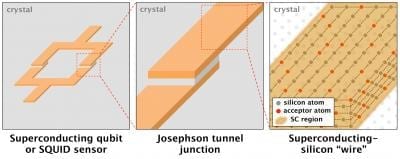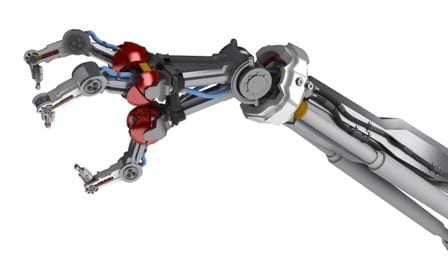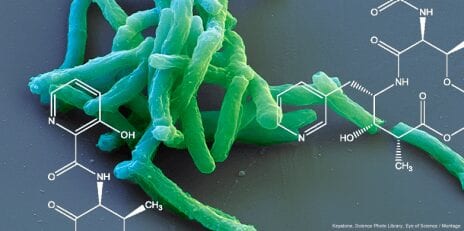Using a bottom-up approach to make hybrid quantum devices
Theorists propose a way to make superconducting quantum devices such as Josephson junctions and qubits, atom-by-atom, inside a silicon crystal. Such systems could combine the most promising aspects of silicon spin qubits with the flexibility of superconducting circuits. The researcher’s results have now been published in Nature Communications.
High quality silicon is one of the historical foundations of modern computing. But it is also promising for quantum information technology. In particular, electron and nuclear spins in pure silicon crystals have been measured to have excellent properties as long-lived qubits, the equivalent of bits in conventional computers.
In a paper appearing this week in Nature Communications, Yun-Pil Shim and Charles Tahan from the University of Maryland and the Laboratory for Physical Sciences (on the College Park, MD campus) have shown how superconducting qubits and devices can be constructed out of silicon. Doing so can potentially combine the good quantum properties of silicon and the ubiquity of semiconductor technology with the flexibility of superconducting devices. They propose using “bottom-up” nano-fabrication techniques to construct precisely placed superconducting regions within silicon or germanium and show that such “wires” can be used to make superconducting tunnel junctions and other useful superconducting devices.
Beyond the possibility of superconducting circuits built inside a homogeneous silicon crystal, engineered superconducting-semiconductor devices like these could be used to build other types of exotic quantum many-body systems, at the atomic scale, and even act as testbeds for our understanding of superconductivity itself.
Read more . . .
The Latest on: Hybrid quantum devices
[google_news title=”” keyword=”Hybrid quantum devices” num_posts=”10″ blurb_length=”0″ show_thumb=”left”]
via Google News
The Latest on: Hybrid quantum devices
- Light Brought 'To a Halt' in Quantum Breakthroughon April 26, 2024 at 10:16 am
The bizarre feat can be achieved in special, two-dimensional crystals by deforming them only slightly, a new study discovered.
- Corporate-Owned IoT Devices Are High Risk & ‘Under Siege’, Experts Warnon April 26, 2024 at 4:54 am
The Internet of Things is a critical risk factor that can severely inflate an organization's cyber incident financial burden, according to experts.
- The Top 3 Quantum Computing Stocks to Buy in April 2024on April 26, 2024 at 4:30 am
InvestorPlace - Stock Market News, Stock Advice & Trading Tips When the largest American bank, JPMorgan Chase (NYSE:JPM), starts investing ...
- Tweak to Schrödinger's cat equation could unite Einstein's relativity and quantum mechanics, study hintson April 26, 2024 at 2:00 am
Physicists have proposed modifications to the infamous Schrödinger's cat paradox that could help explain why quantum particles can exist in more than one state simultaneously, while large objects ...
- Quantum forces used to automatically assemble tiny deviceon April 25, 2024 at 1:48 am
The very weak forces of attraction caused by the Casimir effect can now be used to manipulate microscopic gold flakes and turn them into a light-trapping tool ...
- Microsoft And Quantinuum Improve Quantum Error Rates By 800xon April 18, 2024 at 5:22 pm
Microsoft and Quantinuum researchers have achieved a significant improvement in quantum error correction that could pave the way for more powerful quantum computers.
- Major First: Quantum Information Produced, Stored, And Retrievedon April 17, 2024 at 9:43 pm
The potential of quantum computing is immense, but the distances over which entangled particles can reliably carry information remains a massive hurdle.
- LBNL Leads Quantum Data Storage, Visualization Projecton April 17, 2024 at 1:12 pm
Lawrence Berkeley National Laboratory has announced that national lab and university researchers recently released two papers introducing new methods of data storage and analysis to make quantum ...
- Crucial connection for 'quantum internet' made for the first timeon April 16, 2024 at 8:37 am
Researchers have produced, stored, and retrieved quantum information for the first time, a critical step in quantum networking.
- Mauro Paternostro: a vision of the quantum landscapeon April 16, 2024 at 3:00 am
Quantum physicist Mauro Paternostro talks to Tushna Commissariat about the future of the quantum technology landscape ...
via Bing News










